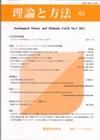Volume 21, Issue 1
Displaying 1-13 of 13 articles from this issue
- |<
- <
- 1
- >
- >|
Presidential Address
-
2006Volume 21Issue 1 Pages 1-10
Published: April 30, 2006
Released on J-STAGE: August 01, 2007
Download PDF (256K)
Special Articles
-
2006Volume 21Issue 1 Pages 11-12
Published: April 30, 2006
Released on J-STAGE: March 27, 2009
Download PDF (126K) -
2006Volume 21Issue 1 Pages 13-32
Published: April 30, 2006
Released on J-STAGE: August 01, 2007
Download PDF (322K) -
2006Volume 21Issue 1 Pages 33-48
Published: April 30, 2006
Released on J-STAGE: August 01, 2007
Download PDF (297K)
Articles
-
2006Volume 21Issue 1 Pages 49-61
Published: April 30, 2006
Released on J-STAGE: August 01, 2007
Download PDF (273K) -
2006Volume 21Issue 1 Pages 63-76
Published: April 30, 2006
Released on J-STAGE: August 01, 2007
Download PDF (377K) -
2006Volume 21Issue 1 Pages 77-91
Published: April 30, 2006
Released on J-STAGE: August 01, 2007
Download PDF (501K) -
2006Volume 21Issue 1 Pages 93-107
Published: April 30, 2006
Released on J-STAGE: August 01, 2007
Download PDF (236K) -
2006Volume 21Issue 1 Pages 109-130
Published: April 30, 2006
Released on J-STAGE: August 01, 2007
Download PDF (773K)
Translated Article
-
2006Volume 21Issue 1 Pages 131-156
Published: April 30, 2006
Released on J-STAGE: August 01, 2007
Download PDF (407K)
Book Reviews
-
2006Volume 21Issue 1 Pages 157-163
Published: April 30, 2006
Released on J-STAGE: March 27, 2009
Download PDF (262K)
Errata
-
2006Volume 21Issue 1 Pages 164_e1
Published: April 30, 2006
Released on J-STAGE: March 27, 2009
Download PDF (71K) -
2006Volume 21Issue 1 Pages 164_e2
Published: April 30, 2006
Released on J-STAGE: March 27, 2009
Download PDF (71K)
- |<
- <
- 1
- >
- >|
